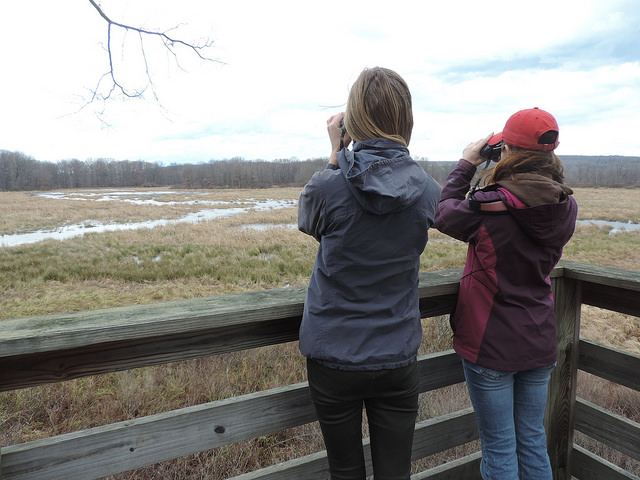Ducks, in the right circumstances, can roar. They do not roar alone, but only in company. One duck by itself flies with a special kind of wingbeat, fast and furious, like a racing heartbeat after some great scare. Five ducks whir along with flair. Five thousand whirring duck wings make a roar that I feel deep in my chest. It reminds me of the way a bass drum in a parade echoed through my skinny body when I was a child at the Memorial Day parade: a deep and thrilling thump that had some indefinable thrill to it.
My first experience with that amazing roar of wings was on an Audubon field trip to the Oak Orchard Wildlife Management Area near Buffalo, New York. My job was to drive the van, since I really didn’t know much about how to identify birds.
We stood on a huge tower as tiny dots swam through my binoculars. Around me, people were shouting things like “Pintails!” and “Wood Ducks!” Somehow, all these people around me were looking at dots and seeing ducks. It was eye opening and, with the generosity of spirit common to birders, they shared what they were seeing with me so my eyes could learn to interpret the same dots as ducks.
It was educational until something spooked the ducks. Suddenly, the air was filled with the roaring of wings as the ducks whipped out of the water and circled around with whirring wings flailing the air. Educational quickly turned magical as hundreds or thousands of ducks took off and flew as one massive flock in circles before settling down again.
Oak Orchard is part of a 5,600 acre wetland that has been set aside for migrating waterfowl by New York. This is paid for by a special tax on guns and ammunition, as well as the purchase of hunting licenses. A special thank you goes out to the hunters who have made it possible to conserve these and other large pieces of land. The Iroquois National Wildlife Refuge, which is nearby, was preserved with money from the sale of Federal Duck Stamps, which are purchased by waterfowl hunters.
Ducks and other waterfowl migrate north in the spring in huge flocks. They appear suddenly, as the wind and weather helps push them north. A pond can be empty one day and filled the next. Some places have been set aside specifically for waterfowl migration and the numbers of different ducks that use those preserves is amazing.
Oak Orchard is one of several Wildlife Management Areas in Western New York, but it is famous for the odd birds that occasionally blow in. A quick look at ebird.org, a website run by the Cornell Lab of Ornithology to collect bird information, shows that some interesting and rare species show up at Oak Orchard. Their bird list is full of things like Cackling Geese, Barnacle Geese, American White Pelicans and even a Glossy Ibis.
There is no guarantee that any of these birds will be there at any one time, but the Audubon Community Nature Center is leading a group of people there on Saturday, April 8 from 6:30 a.m. till 5:00 p.m. during what is anticipated to be the peak of the spring migration.
E-bird data compiled from 1900 until present day show that this weekend has great potential for some amazing and rare birds. Over 30 species of waterfowl, herons and sandpipers may be seen migrating through the area during the beginning of April. This weekend has also had Cackling Geese, Snow Geese and large numbers of Tundra Swans. Mathematically, there are good odds of finding interesting birds this weekend in potentially stunning numbers.
This field trip was led for years by dedicated Audubon volunteer Linda O’Brien, whose love for birds inspired many children and adults over the years. Linda sent me lists of what was seen on this trip over the years. The field trip is being offered as part of Audubon’s 60th Anniversary Celebration, as we revisit some of the most popular trips, events and activities that we have led over the last several decades. Every year had 40 to 55 species of birds seen on that day. Whether you join us or explore Oak Orchard on your own, it is definitely worth a visit.
Reserve at online by April 2 to claim a spot in the van. Nature Center members pay $30 while non-members pay $40 for this all-day field trip. If you can’t make the trip, but are still interested in duck watching, ACNC’s own Big Pond often has an interesting smattering of species through the spring migration. Visit auduboncnc.org or call (716) 569-2345 for more information.
ACNC builds and nurtures connections between people and nature. The trails are open from dawn to dusk. The Nature Center is open daily from 10:00 a.m. until 4:30 p.m. except Sundays, free admission day, when it opens at 1:00 p.m.
Jeff Tome is a naturalist at the Audubon Community Nature Center.


Recent Comments